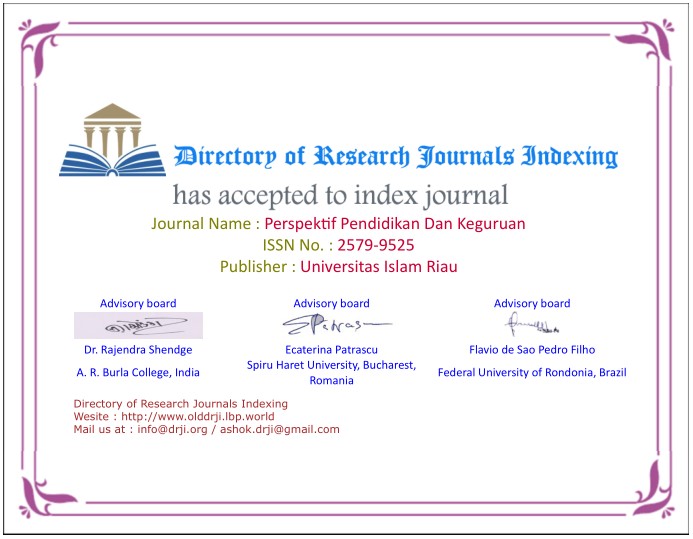Jama'ah Response to The Art of The Imam's Tilawah in The Reading of Prayers in The Pekanbaru City Mosque
DOI:
https://doi.org/10.25299/perspektif.2024.vol15(1).16217Keywords:
Imam's recital, musical aspect, congregation's responseAbstract
This research aims to look at the musical aspects contained in the imam's recital of recitations during congregational prayers. Apart from that, this research also aims to see the response of the congregation when attending congregational prayers. In order to obtain data related to the intended objectives, researchers used qualitative methods. The data collection techniques used were interviews, observation and documentation. Interviews were conducted with two mosque imams who have good recitation skills, as well as several mosque congregation members who are members of the Subuh Warriors community. From the results of the analysis, it was concluded that the rhythm of the recitation songs commonly used by the two imams in question were the bayati and jiharka rhythms. The results of the analysis of the congregation's response were past responses, future responses and current responses. These various responses are shown through the reactions that emerge from each congregation. The differences in responses that lead to this reaction are caused by differences in spiritual experiences, including personal life experiences and religious experiences that have been experienced.
Downloads
References
Al-Faruqi, I. R. (1999). Seni Tauhid: Esensi dan Ekspresi Estetika Islam. Terj. Hartono Hadikusumo. Yogyakarta: Yayasan Bentang Budaya.
Alamsyah, Z., & Suherman, A. (2022). Karinding: dari ungkapan hati menjadi karya seni (sebuah tinjauan etnomusikologi). Virtuoso: Jurnal Pengkajian Dan Penciptaan Musik, 5(2), 125–133.
Andita, C. D., & Desyandri, D. (2019). Pengaruh penggunaan musik terhadap konsentrasi belajar anak sekolah dasar. Edukatif: Jurnal Ilmu Pendidikan, 1(3), 205–209.
Copland, A. (1939). What to Listen for in Music. New York: McGraw-Hill Book Company.
Djohan Salim. (2009). Psikologi Musik. Yogyakarta: PT. Kanisius.
Donner, L., & Elvers, M. (2017). Platelets and neurodegenerative diseases. Platelets in Thrombotic and Non-Thrombotic Disorders: Pathophysiology, Pharmacology and Therapeutics: An Update, 1209–1224.
Kaemmer, E. J. (1993). Music in Human Life. Austin: University of Texas Press.
Muradi, A. (2018). Pemerolehan bahasa dalam perspektif psikolinguistik dan Alquran. Tarbiyah: Jurnal Ilmiah Kependidikan, 7(2).
Patton, M. Q. (2002). Qualitative research & evaluation methods (3rd ed.). London: Sage Publications.
Penumbra, S., Jatmika, O. B., & Laksono, K. (2023). Ngĕng: Penerapan Rasio Interval pada Sumber Bunyi Non Pitch. IDEA: Jurnal Ilmiah Seni Pertunjukan, 17(1).
Rahmah, S., & Fitriani, D. R. (2018). Analisis Praktik Klinik Kesehatan Jiwa pada Bp. E dengan Intervensi Inovasi Latihan Relaksasi dan Terapi Musik terhadap Resiko Perilaku Kekerasan di Ruang Elang Rumah Sakit Jiwa Daerah Atma Husada Mahakam Samarinda Tahun 2018.
Rakhmat, J. (2021). Psikologi Komunikasi. Bandung: PT. Remaja Rosda Karya. Online, Diakses Pada, 15.
Situmorang, A., & Munthe, P. (2021). Tinjauan Dogmatis Terhadap Upaya Mengadopsi Musik Patam-Patam Dalam Ibadah Di Gbkp Bunga Rampe. Jurnal Sabda Akademika, 1(2), 1–7.
Yuliana, A. R., Pujiastuti, S. E., & Hartati, E. (2020). Efektifitas Terapi Musik Klasik Monzat Dalam Meningkatkan Kecerdasan Emosi Pada Anak Sekolah Usia Dasar. Jurnal Keperawatan Dan Kesehatan Masyarakat Cendekia Utama, 9(1), 46–56
Downloads
Published
How to Cite
Issue
Section
License
Copyright (c) 2024 Idawati Arman, Armansyah Anwar, Sudirman Soemary, Khoirun Nisa Rusdi

This work is licensed under a Creative Commons Attribution-NonCommercial-ShareAlike 4.0 International License.
Accepted 2024-05-06
Published 2024-05-10
















